HISTORY
This is the very building from where Shrila Bhakti Siddhanta Saraswati Thakur had started his missionary works in 1918, just after accepting renounced order or Sannyasa. His missionary work grew into a pan India movement named Gaudiya Math, with 64 temples by the end of Shrila Saraswati Thakur’s worldly pastime.
Here Shrila Bhakti Siddhanta Saraswati Thakur had met many of his prominent and leading disciples for the first time. Their spiritual journey began here. Later they had become exponent of the Bhakti movement and connected many more in this path. Thus, this place is extremely significant in the entire history of Gaudiya Vaishnavaism. Practically, this place is the like the root of organized propagation of Krishna consciousness in the modern history.


In one evening of 1922, in such a meeting here, Shrila Bhakti Siddhanta Saraswati Thakur had met one enthusiastic young Bengali gentleman, Abhay Charan De, who later became his disciple. After a few decades this Abhay Charan De became famous as Shrila A.C. Bhaktivedanta Swami Prabhupada, the Founder-Acharya of ISKCON, the worldwide Hare Krishna movement.
In the very first meeting only, in the terrace of this building, young Abhay Charan De got a Prophetic instruction from his spiritual master, ” You are educated young man. Why don’t you preach Lord Chaitanya Mahaprabhu’s message throughout the whole world? ” This seed instruction later fructified in form of worldwide Hare Krishna movement which is most popularly known as International Society for Krishna Consciousness, or ISKCON. In that sense, this building is the spiritual birthplace of ISKCON.
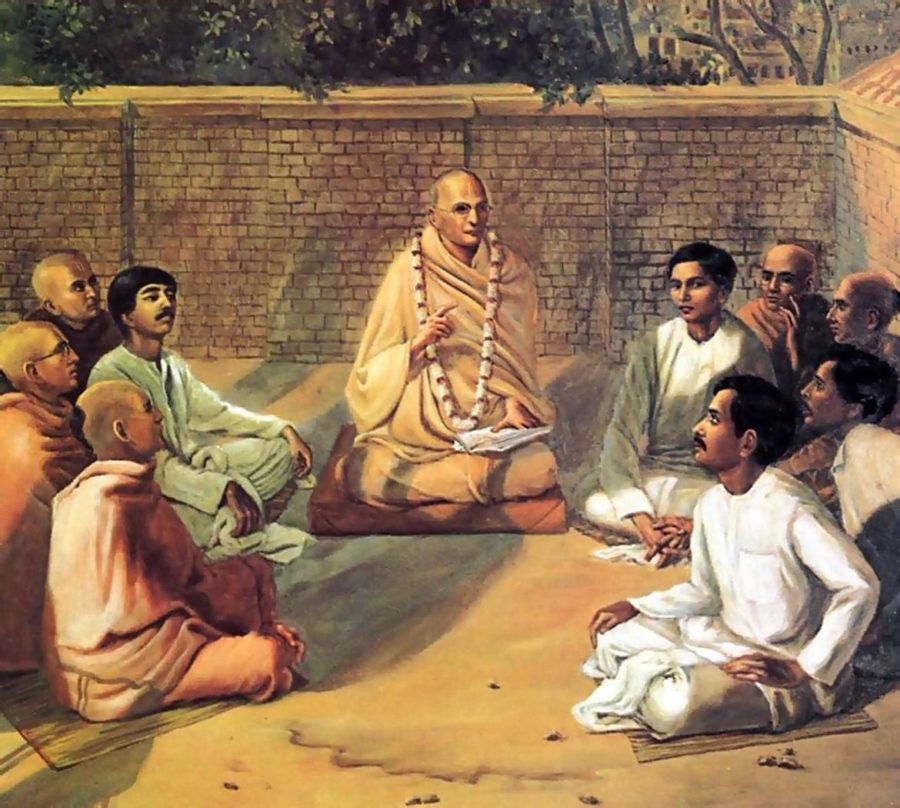
PAST SITUATION
This property of Bhaktivinode Asan was on the name of a deity called Sridhar Thakur jiu. There is an old Sridhar Thakur jiu temple within 100 m of Bhaktivinode Asan. According to Indian law, deity can have properties. In 1918, Srila Bhaktisiddhanta Saraswati Thakur Prabhupada had rented this property in monthly Rs. 50. It was quite a high amount that time. Later when Bagbazar Gaudiya Math had been constructed and all the devotees shifted there, this property came back to the hand of Sridhar Thakur Jiu trust.
From that time to 2003, three tenants were staying here in this property. Most amazingly, by Krishna’s inconceivable arrangement, though all the contemporary buildings around this building had been replaced by new constructions, this building remained untouched. Though several attempts were made to demolish the building, those attempts didn’t succeed.
In between, one devotee from ISKCON padayatra, HG Krishnanda Pr identified this place as and requested ISKCON, Kolkata Management to take over it. So, devotees started putting their efforts. Finally, two tenants were peacefully relocated with negotiation. And in 2008, this property got registered in the name of ISKCON. Still one tenant was remaining. In 2017, they were also relocated peacefully. So, ISKCON got full possession of the property. After that in 2018, by the mercy of all the GBCs and Vaishnavas, the restoration work began.
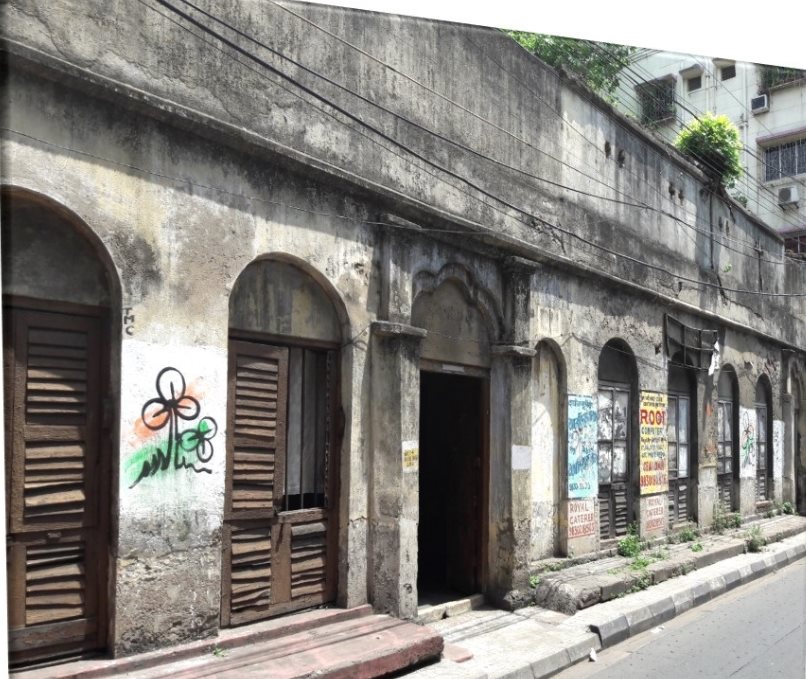

PRESENT SITUATION
Presently the building has been renovated or reconstructed the way it was. From the colour of the door to design of the windows, from the kadi-barga roof to the design of the sunshades, from the old stair case to the red flooring, everything together takes us 100 years back. In word of one devotee, it’s a transcendental time machine.
Presently it has a deity room, a deity dress room, a kitchen, a dol mandap, a Tulsi mandir, two guest rooms, a meeting room, a grand museum, an office, two rooms for sevaks and a central ‘Thakur Dalan’ or in the ground floor. In the first floor there is that terrace where Srila Bhaktisiddhanta Saraswati Thakur Prabhupada used to give class. His personal room, his kitchen and his personal washroom is also there. The exact place of meeting between Srila Bhaktisiddhanta Saraswati Thakur Prabhupada and our Srila Prabhupada, Abhay Charan de, has been specially beautified with a shade. Other than that, two room has added in the terrace as brahmacari ashram.
It is a best place for meditation, contemplation and offering prayers.
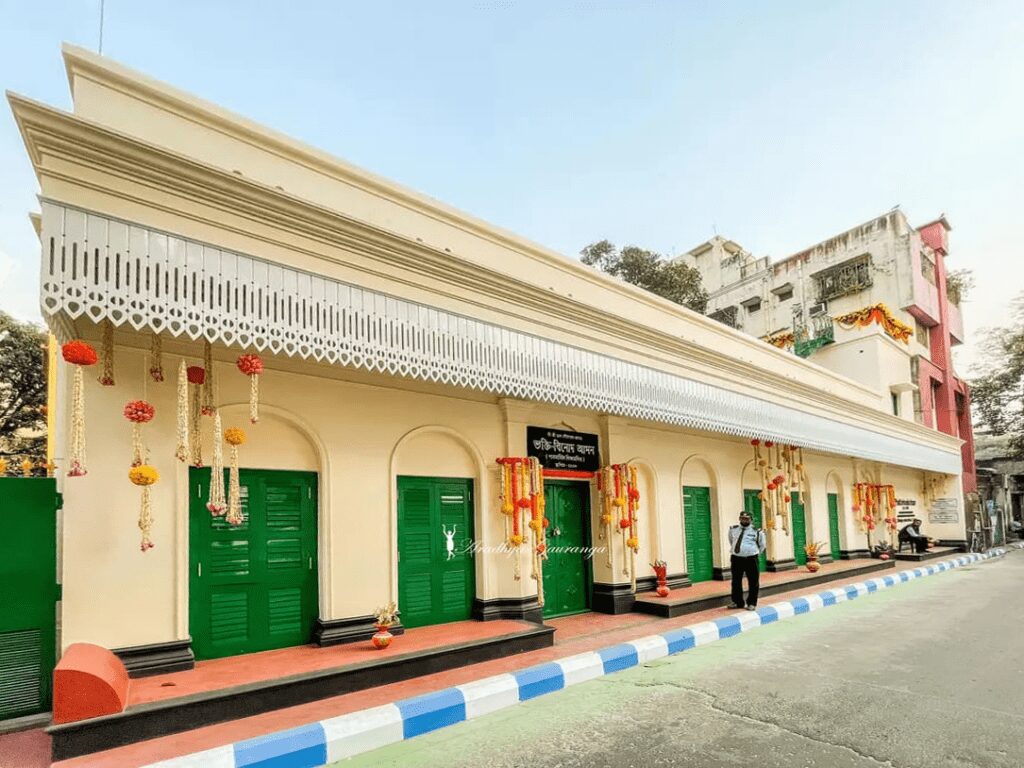
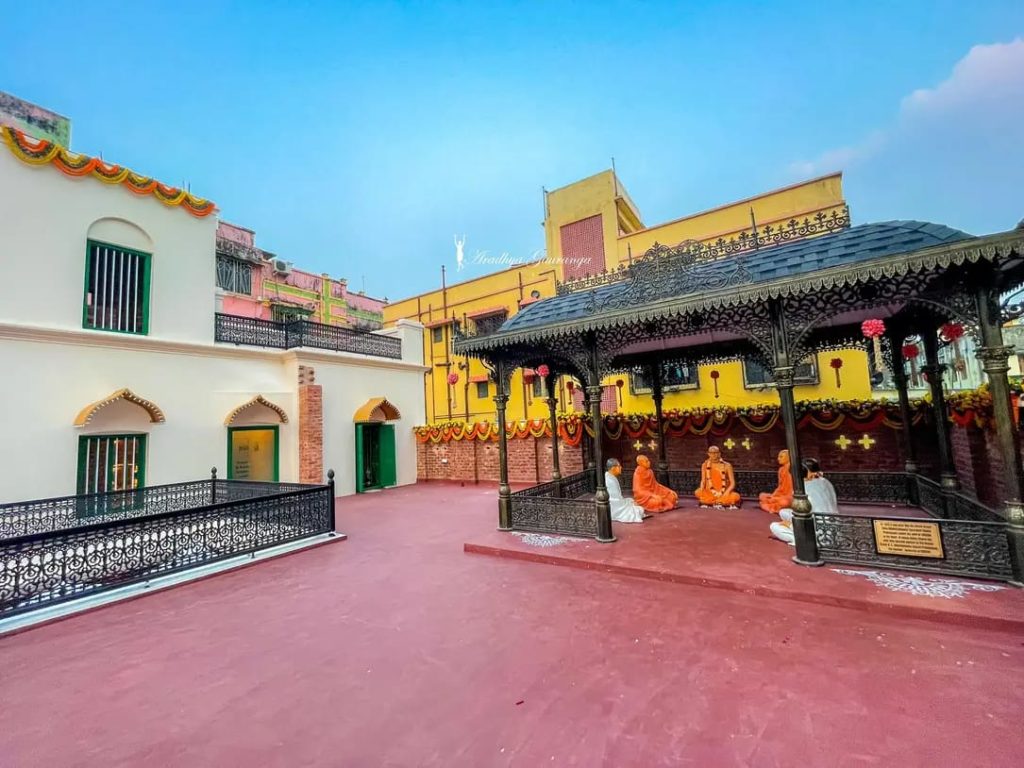
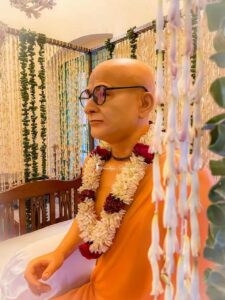
Inauguration Phase 1
After thorough renovation, the Bhaktivinode Asan had again been opened for all on 21st February, 2022 on 148th appearance day of Srila Bhaktisiddhanta Saraswati Thakur Prabhupada. The year 2022 is also very special. This year marks the 100th year of the prophetic meeting between Srila Bhaktisiddhanta Saraswati Thakur Prabhupada and Abhhay Charan De, who later became known as Srila A.C. Bhaktivedanta Swami Prabhupada, the Founder-Acharya of International Society for Krishna Consciousness.
A grand and culturally rich festival on 21st February in celebration of inauguration of Bhaktivinode Asan caught attention of many, including politicians, journalists, people of Kolkata and the ISKCON world. The festival was graced by HG Jananivas Pr along with GBC members like HH Bhakti Purusottam Swami maharaj, Hg Gouranga pr and HG Hridaya Chaitanya pr. There were other special guests like HG Devaki Nandan pr, HG Naru Gopal pr, HG Vraj Vilas pr, HG Suveksana Pr etc. Minister of woman and child welfare, West Bengal Government, Smt. Sashi Panja was also present. HH Jayapataka Swami maharaj , HH Radhanath Swami Maharaj, and HH Loknath swami maharaj were present in on-line mode. It was a very memorable and heart touching program.
Activities
After the phase-1 inauguration of the renovated building on 21st February 2022, now the Bhaktivinode Asan has been made available for darshan of the general public and devotees from all over the world. Presently it is functioning as a small preaching center under ISKCON, Kolkata temple. We have Sri Sri Gandharvika Giridhari deities here.
We are having the following Daily Deity Seva at Bhaktivinode Asan every day:
• Mangal Arati Seva (4:30 AM) followed by Nrisimha Arati, Tulasi Pranam, Siksastakam, Japa session
• Sakalika Darshan Arati Seva (7:30 AM)
• Mangal Bhog Dhoop Arati Seva (8:30 AM)
• Raja Bhoga Arati Seva (12:00 PM)
• Vaikalika Dhoop Arati Seva (4:00 PM)
• Sandhya Arati Seva (6:00 PM)
• Shayana Dhoop Arati Seva (8:00 PM)
We have the following Spiritual Discourses:
• Saturday – 5:00 PM to 6:00 PM
• Sunday – 9:00 AM to 10:00 AM & 5:00 PM to 6:00 PM
Temple Open Hours
Morning Timings:
• Mangal Arati: 4:30 AM – 5:00 AM
• Darshan Arati: 7:30 AM – 1:00 PM
Evening Timings:
• Darshan Arati: 4:00 PM – 8:00 PM
Temple Closed Hours
• 1:00 PM – 4:00 PM
• 8:00 PM – 4:00 AM
It is not only a divine place of worship but also a national heritage building. On top of that, space is very limited here. Therefore, for the protection of this divine property and human safety, we are following certain rules and regulations.
1. Work is still in progress, this place is open for all only on Monday and Wednesday from 10 am to 1 pm.
2. No entry with half pants, three-quarters, shorts, miniskirts, nightdresses, etc. As it is a traditional place and it belongs to His Divine Grace Bhakti Siddhanta Saraswati Thakur Prabhupada, let us dress ourselves, the way we can show our respect to Him.
3. No entry in an alcoholic state. Smoking is not allowed. No entry with any kind of chewing intoxicants e.g. pan or gutka.
4. No entry with any food items or beverages.
5. As the space is limited, a maximum of 15 persons are allowed in one go.
6. Touching of walls, artifacts, paintings and furniture, and deities is prohibited.
7. Silence is appreciated. In necessity, a low indoor voice must be used.
8. Mind your steps. Don’t run, jump or play in the corridor.
9. Photographs with flashlights are prohibited.
10. Cell phones are to be kept in silent mode.
11. As the space is limited, everyone is requested to move ahead fast to give others a chance to take Darshan. It’s recommended that visitors keep their stay limited between 10 to 15 minutes.
12. We are trying to be utmost attentive, sensitive, careful, and prayerful while visiting this place.
For taking Darshan in a group, the organizer has to contact our office and book the date and time of the Darshan in advance.
For booking Darshan please get in touch with HG Parananda Das at +91 9903000921.
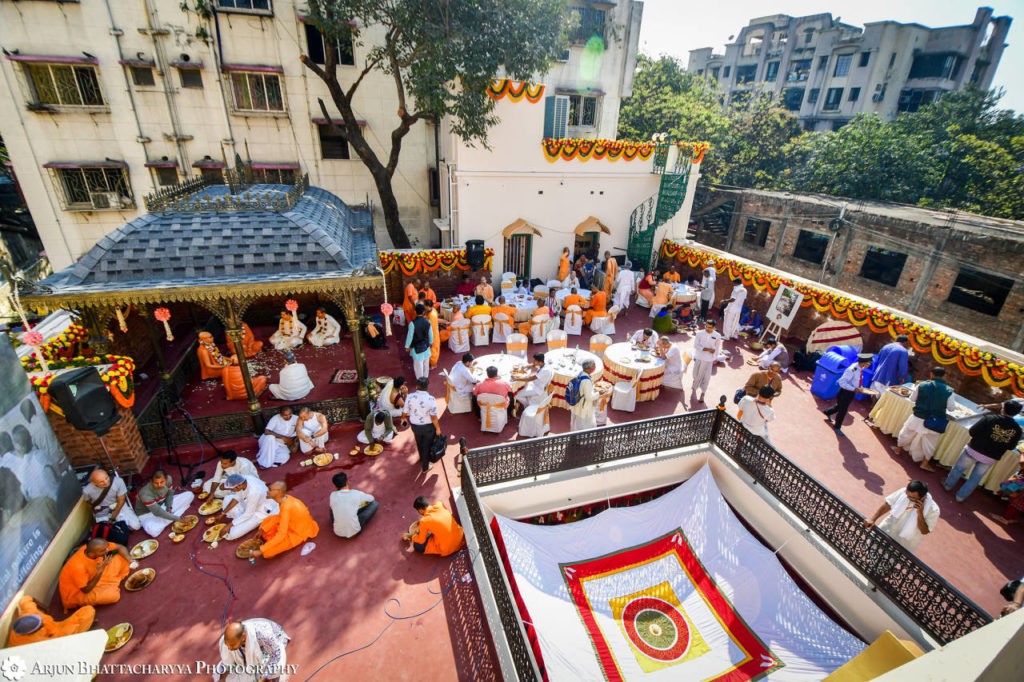
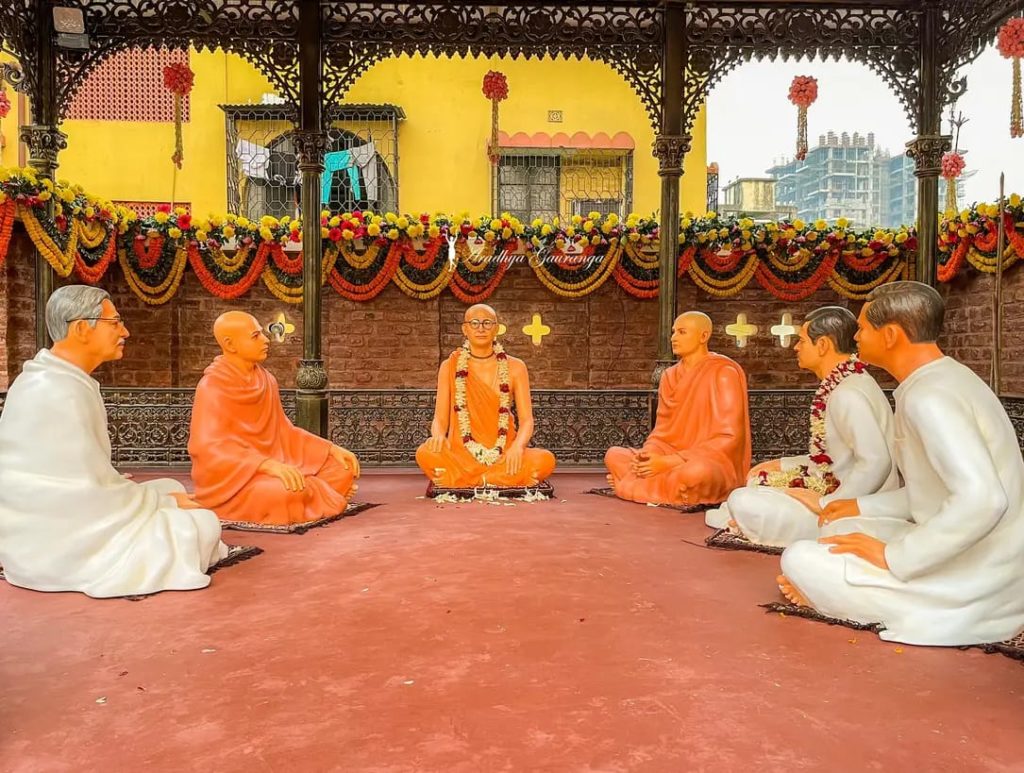
Activities
This hallowed building which was formerly known as “1, Ultadanga Junction Road” holds a very special position in the history and evolution of the Gaudiya Vaishnavism. It was here that Srila Bhaktisiddhanta Saraswati Thakur Prabhupada (1874-1937), the renowned Vaishnava Acharya and revivalist, established the Bhaktivinode Asan in November 1918. This building also housed the first Gaudiya Maṭh in 1920. And in 1922, in terrace of this very building, Srila Bhaktisiddhanta Saraswati Thakur Prabhupada had sown the seed of ISKCON in the heart of young Abhay Charan De, who later became popular as Srila A.C. Bhaktivedanta Swami Prabhupada, the Founder-Acharya of ISKCON.
The Bhaktivinode Asan and later the Gaudiya Math became the nodal center for a diverse range of devotional activities for the propagation of suddha bhakti. Worship, congregational chanting of holy name, lecture discourses, informal and formal interaction between devotees and celebrated guests were among the regular programs conducted from here. It was also the venue for the editing and publication of Vaishnava periodicals. From here Srila Bhaktisiddhanta Saraswati Thakur’s travel for devotional propagation across Bengal and India was initiated. The following list provides a brief preview and historic account of these glorious activities:
In the month of December 1918, Srila Bhaktisiddhanta Saraswati Thakur Prabhupada started his preaching from Bengal to various other parts of India and in present day Bangladesh.
• First preaching had started from Bengal in 1918 and then he went to Dhaka and various other parts of present-day Bangladesh.
• On the appearance day of Vishnupriya Devi on 5th February 1919, he re-established the Sri Viswa Vaishnava Raj Sabha at Bhaktivinode Asan.
• In early April 1920, Sri Bhaktivinode Asan was culminated into the Math after all the grihasthas (householder devotees) had moved out.
• On 6th September 1920, on the occasion of Krishna Janmashtami, Srila Bhaktisiddhanta Saraswati Thakur installed a large deity of Mahaprabhu and two small deities of Radha & Krishna and named them Sri Sri Guru Gauranga & Sri Sri Gandharvika Giridhari. From this day onward, the Sri Bhaktivinode Asan was also named as Sri Gaudiya Math. (Thought we will refer it here as Bhaktivinode Asan only).
• In the second week of September 1920, king Damodar Varman visited Sri Bhaktivinode Asan. Also, renowned personalities such as Sir Debaprasad Sarbadhikari, Ray Bahadur Radhacharan Pal, Jatindranath Chaudhuri, the zamindar of Chaki came to listen to the discourses of Srila Bhaktisiddhanta Saraswati Thakur.
• On 26th September 1920, Sir Manindra Chandra Nandi Bahadur, the king of Kasimbazar in Murshidabad visited Sri Bhaktivinode Asan.
• The former Vice-Chancellor of Calcutta University, Bhupendranath Basu, on a number of occasions, came to meet and hear Hari Katha from Srila Bhaktisiddhanta Saraswati Thakur at Bhaktivinode Asan.
• In 1922, in a prophetic meeting here, Srila Bhaktisiddhanta Saraswati Thakur Prabhupada had sown the seed of ISKCON in the heart of young Abhay Charan De, who later became popular as Srila A.C. Bhaktivedanta Swami Prabhupada, the Founder-Acharya of ISKCON, the worldwide Hare Krishna movement. Before any preliminary formalities of conversation had begun, Saraswati Thakur immediately said to Abhay, “You are educated young men. Why don’t you preach Lord Caitanya Mahaprabhu’s message throughout the whole world?”
• In 1923, due to the desire and efforts of Srila Bhaktisiddhanta Saraswati Thakur, the “Gaudiya Printing Works” was established near Bhaktivinode Asan (243/2, upper circular road).
• On 24th February 1924, the devotees of Bhaktivinode Asan introduced the first Vyasa Puja of Srila Bhaktisiddhanta Saraswati Thakur Prabhupada when he had reached the age of 50.
• In July 1924, Srila Bhaktisiddhanta Saraswati Thakur established the Sri Saraswat Asan at Bhaktivinode Asan. This was a set up to facilitate the teaching and study of the students of the Nabadwip Saraswat Pitha who were preparing for Bhakti Shastri exams.
• On 6th September 1924, Raut-Roy-Saheb (a relative of the king of Mayurbhanj, Maharaja-Bahadur), Manmathanath Mukhopadhyay (the honorable justice of High Court), and Professor Sri Khagendranath Mitra Bahadur and many other esteemed guests visited the Bhaktivinode Asan to hear lectures from Srila Bhaktisiddhanta Saraswati Thakur.
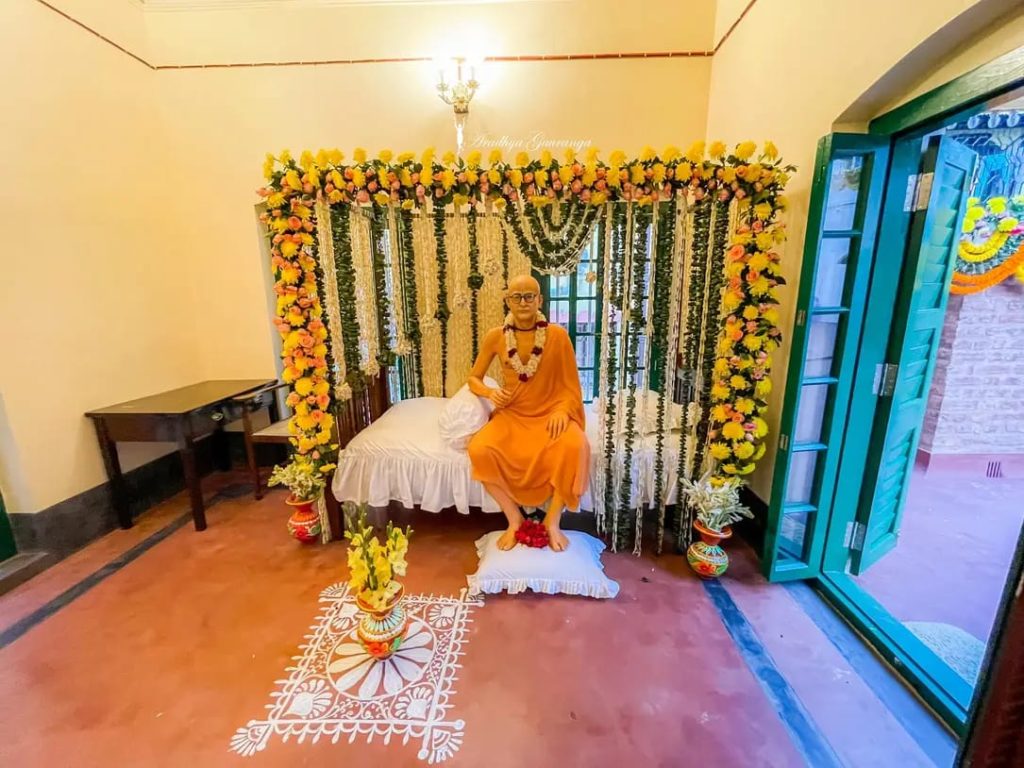
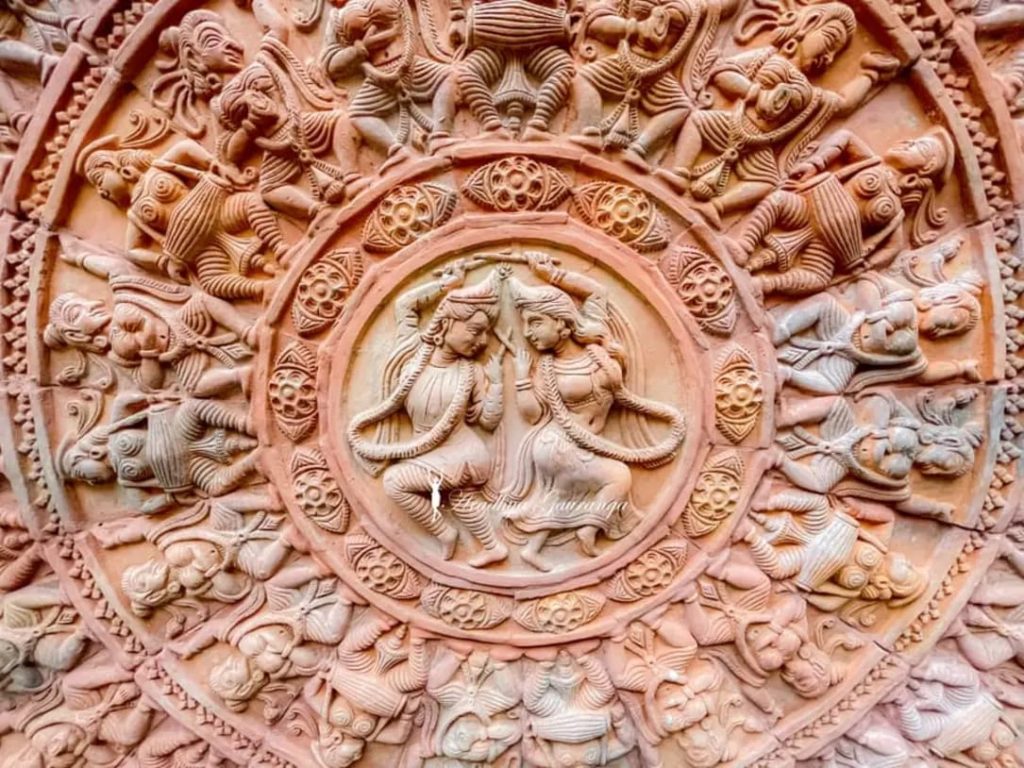
• In October 1924, the prime minister’s son of the independent king of Nepal, His Excellency general Punya Samser Rana Jang Bahadur along with his private secretary Sri Bhabendranath B.L. and a court scholar arrived at Bhaktivinode Asan to meet and hear lectures from Srila Bhaktisiddhanta Saraswati Thakur. He delivered a lecture for more than two hours on Srimad Bhagvad Gita and the doctrines of Vedanta on this day.
• On 17th April 1925, Friday, Pandit Madanmohan Malaviya, renowned Sishir Kumar Ghosh’s talented son Pijuskanti Ghosh, Pandit Panchanan Tarkaratna’s son Sri Jiva Nyayatirtha and a few others came to Bhaktivinode Asan to have darshan of Srila Bhaktisiddhanta Saraswati Thakur.
• On 24th May 1927, the devotees of Bhaktivinode Asan delivered lectures on the teachings of Sri Chaitanya Mahaprabhu at Darbhanga Building, Calcutta University.
• In June 1927, Sree Sajjan Toshani or The Harmonist Journal was published in English for the first time to make the people of India and abroad acquainted with the philosophy of the Gaudiya Vaishnavism.
• On 20th April 1928, Father P. Johans, a Jesuit priest and a teacher of philosophy of St. Xaviers College visited Bhaktivinode Asan and met Srila Bhaktisiddhanta Saraswati Thakur.
• On 16th September 1928, Dr Morano M.L.C president of A.I.C visited Bhaktivinode Asan to meet Srila Bhaktisiddhanta Saraswati Thakur. He was deeply motivated by the speech of Srila Bhaktisiddhanta Saraswati Thakur on Sri Chaitanya Mahaprabhu and inspired Saraswati Thakur to preach the doctrines of Lord Chaitanya in Europe.
• On 26th September 1928, the ground laying foundation ceremony of Sri Bagh bazaar Gaudiya Math was organized.
• In 1928, Srila Bhaktisiddhanta Saraswati Thakur and many of his associates delivered lectures at several conferences at Albert Hall, Calcutta.
• In August 1929 by the desire of Srila Bhaktisiddhanta Saraswati Thakur, the Visva Vaishnava Conference and Exhibition was organized at the ongoing construction site of Bagh Bazar Gaudiya Math. People across the world who had been interested in Gaudiya Vaishnavism attended the ceremony.
• Srila Bhaktisiddhanta Saraswati Thakur along with associates entered the newly built temple at Bagh Bazaar on 5th October 1930 from Bhaktivinode Asan.
• On 5th October 1930, on the auspicious occasion of the ceremony of installation and entry in the new Math, the mayor of Calcutta, Netaji Subhas Chandra Bose had participated in the grand festival and met Srila Bhaktisiddhanta Saraswati Thakur. (On 12th October 1930, the English daily ‘Liberty’ newspaper published this news).
During his stay at Bhaktivinode Asan, through the preaching programs initiated by him, Srila Bhaktisiddhanta Saraswati Thakur enlightened many educated personalities and erudite scholars of that time. Many royal personalities were also deeply motivated by his interpretations of Bhagavata philosophy. It was during his stay at this house between 1918 to 1930, Srila Bhaktisiddhanta Saraswati Thakur had established several big and small temples in various parts of India and Bangladesh and sent preaching missions. Everyone had sought his divine association and the preaching programs went to every village, town, and cities of India and Bangladesh. Indeed, this devotional preaching had touched the hearts of many national and international scholars, kings, and zamindars of different states and finally many of them became deeply imbued in the ocean of love and devotion of Gaudiya theology.
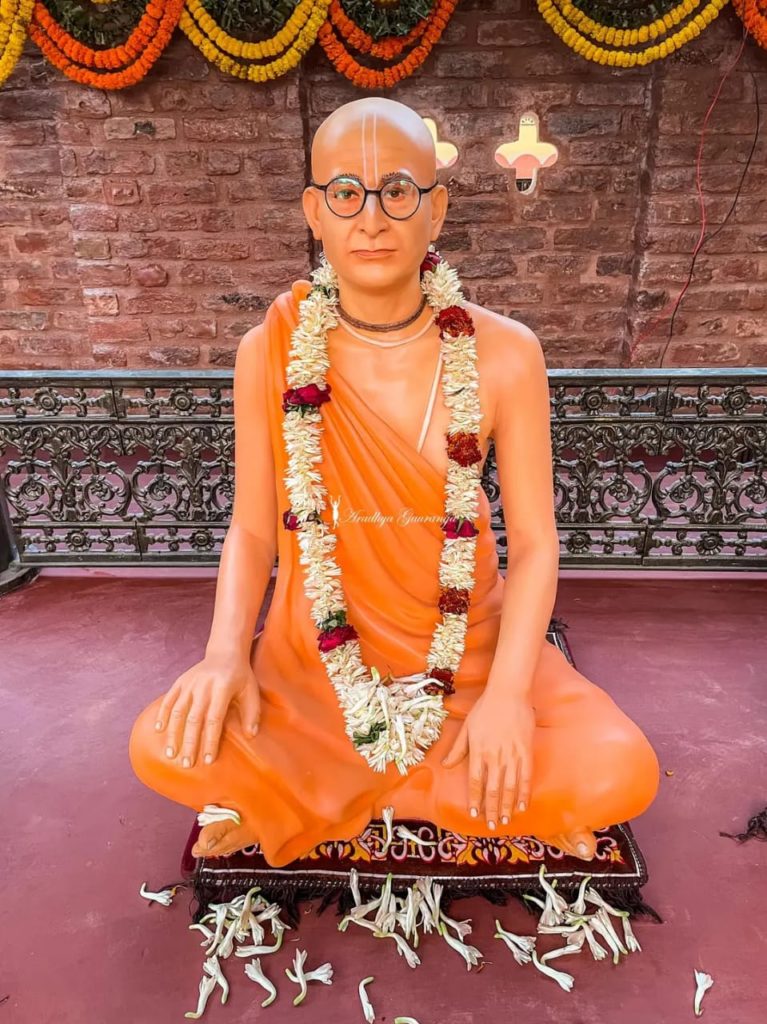
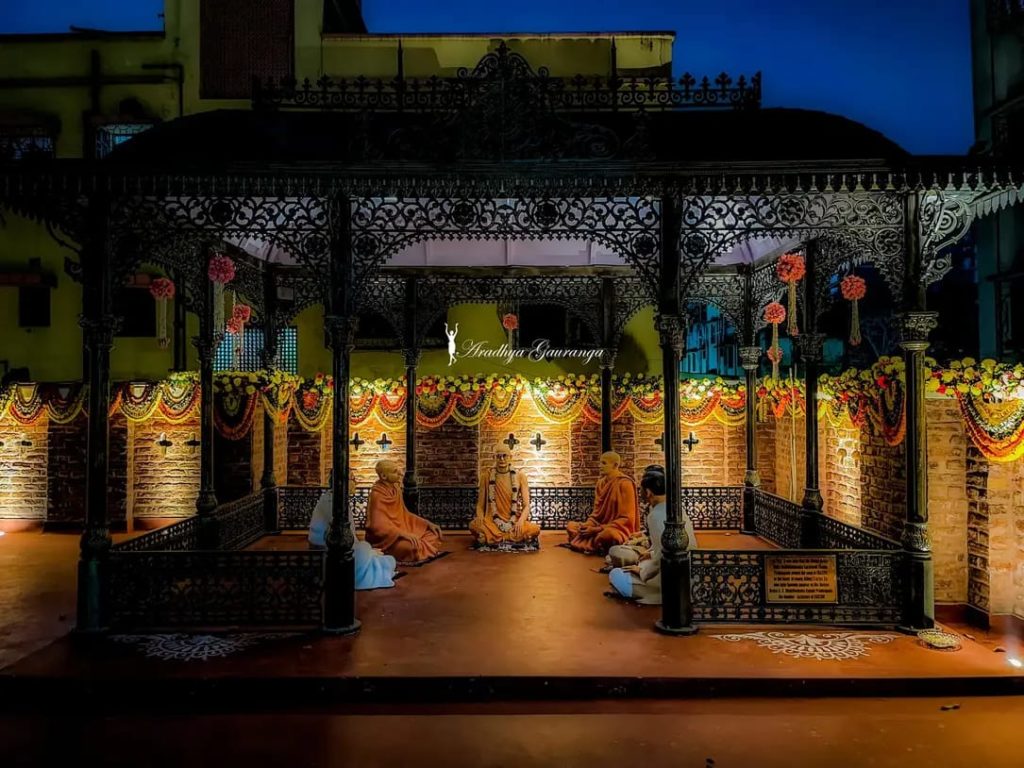
BLESSINGS OF VAISHNAVAS
1. HH Jayapataka Swami Maharaj
2. HH Bhakti Charu Swami Maharaj
3. HH Radhanath Swami Maharaj
4. HG Ananga Mohan Prabhu
Activities at 1, Ultadanga Junction Road
This hallowed building which was formerly known as “1, Ultadanga Junction Road” holds a very special position in the history and evolution of the Gaudiya Vaishnavism. It was here that Srila Bhaktisiddhanta Saraswati Thakur Prabhupada (1874-1937), the renowned Vaishnava Acharya and revivalist, established the ‘Bhaktivinode Asan’ in November 1918. This building also housed the first Gaudiya Maṭh in 1920. And in 1922, in terrace of this very building, Srila Bhaktisiddhanta Saraswati Thakur Prabhupada had sown the seed of ISKCON in the heart of young Abhay Charan De, who later became popular as Srila A.C. Bhaktivedanta Swami Prabhupada, the Founder-Acharya of ISKCON.
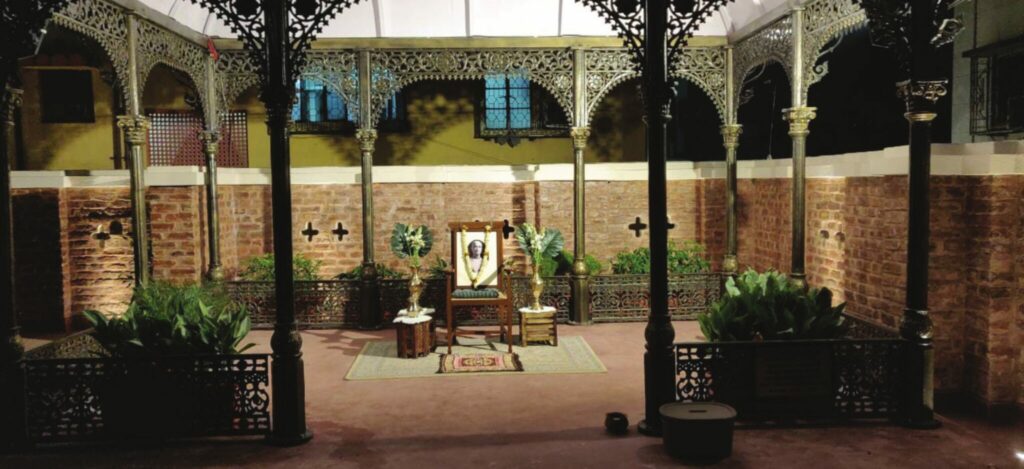
The Bhaktivinode Asan and later the Gaudiya Math became the nodal center for a diverse range of devotional activities for the propagation of suddha bhakti. Worship, congregational chanting of the holy name, lecture discourses, informal and formal interactions between devotees and celebrated guests were among the regular programs conducted from here. It was also the venue for the editing and publication of Vaishnava periodicals. From here Srila Bhaktisiddhanta Saraswati Thakur’s travel for devotional propagation across Bengal and India was initiated.
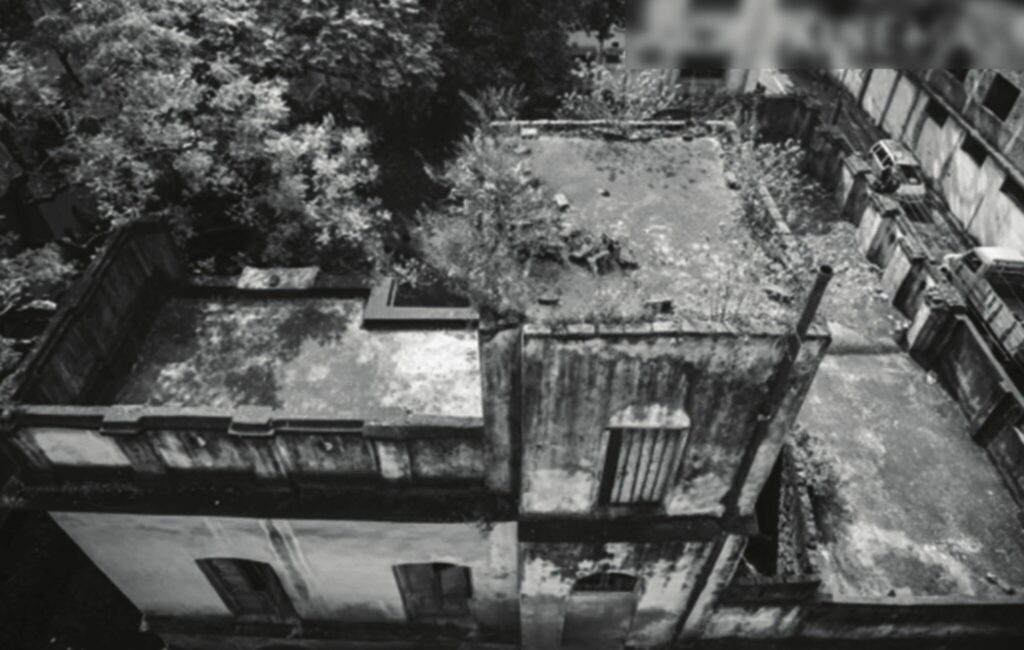
In the month of December 1918, Srila Bhaktisiddhanta Saraswati Thakur Prabhupada started his preaching from Bengal to various other parts of India. The following list provides a brief preview and historic account of these glorious activities:
• First preaching had been started from Bengal in 1918 and then he went to Dhaka and many other places of present-day Bangladesh.
• On the appearance day of Vishnupriya Devi on 5th February 1919, he re-established the Sri Viswa Vaishnava Raj Sabha at Bhaktivinode Asan.
• In early April 1920, Bhaktivinode Asan was culminated into the Math after all the grihasthas (householder devotees) had moved out.
• On 6th September 1920, on the occasion of Krishna Janmashtami, Srila Bhaktisiddhanta Saraswati Thakur installed a large deity of Mahaprabhu and two small deities of Radha & Krishna and named them Sri Sri Guru Gauranga & Sri Sri Gandharvika Giridhari. From this day onward, the Sri Bhaktivinode Asan was also named as Sri Gaudiya Math. (Though we will refer it here as Bhaktivinode Asan only).
• In the second week of September 1920, king Damodar Varman visited Bhaktivinode Asan. Also, renowned personalities such as Sir Debaprasad Sarbadhikari, Ray Bahadur Radhacharan Pal, Jatindranath Chaudhuri, the zamindar of Chaki came to listen to the discourses of Srila Bhaktisiddhanta Saraswati Thakur.
• On 26th September 1920, Sir Manindra Chandra Nandi Bahadur, the king of Kasimbazar in Murshidabad visited Bhaktivinode Asan.
• The former Vice-Chancellor of Calcutta University, Bhupendranath Basu, on a number of occasions, came to meet and hear Hari Katha from Srila Bhaktisiddhanta Saraswati Thakur at Bhaktivinode Asan.
• In 1922, in a prophetic meeting here, Srila Bhaktisiddhanta Saraswati Thakur Prabhupada had sown the seed of ISKCON in the heart of young Abhay Charan De, who later became popular as Srila A.C. Bhaktivedanta Swami Prabhupada, the Founder-Acharya of ISKCON, the worldwide Hare Krishna movement. Before any preliminary formalities of conversation had begun, Saraswati Thakur immediately said to Abhay and one of his friends, “You are educated young men. Why don’t you preach Lord Caitanya Mahaprabhu’s message throughout the whole world?”
• In 1923, due to the desire and efforts of Srila Bhaktisiddhanta Saraswati Thakur, the “Gaudiya Printing Works” was established near Bhaktivinode Asan at 243/2, Upper Circular Road.
• On 24th February 1924, the devotees of Bhaktivinode Asan introduced the first Vyasa Puja of Srila Bhaktisiddhanta Saraswati Thakur Prabhupada when he had reached the age of 50.
• In July 1924, Srila Bhaktisiddhanta Saraswati Thakur established the ‘Sri Saraswat Asan’ at Bhaktivinode Asan. This was a set up to facilitate the teaching and study of the students of the ‘Nabadwip Saraswat Pitha’, who were preparing for Bhakti Shastri exams.
• On 6th September 1924, Raut-Roy-Saheb (a relative of the king of Mayurbhanj, Maharaja-Bahadur), Manmathanath Mukhopadhyay (the honorable justice of High Court), and Professor Sri Khagendranath Mitra Bahadur and many other esteemed guests visited the Bhaktivinode Asan to hear lectures from Srila Bhaktisiddhanta Saraswati Thakur.
• In October 1924, the prime minister’s son of the independent king of Nepal, His Excellency general Punya Samser Rana Jang Bahadur along with his private secretary Sri Bhabendranath B.L. and a court scholar arrived at Bhaktivinode Asan to meet and hear lectures from Srila Bhaktisiddhanta Saraswati Thakur. He delivered a lecture for more than two hours on Srimad Bhagvad Gita and the doctrines of Vedanta on this day.
• On 17th April 1925, Friday, Pandit Madanmohan Malaviya, renowned Sishir Kumar Ghosh’s talented son Pijuskanti Ghosh, Pandit Panchanan Tarkaratna’s son Sri Jiva Nyayatirtha and a few others came to Bhaktivinode Asan to have darshan of Srila Bhaktisiddhanta Saraswati Thakur.
• On 24th May 1927, the devotees of Bhaktivinode Asan delivered lectures on the teachings of Sri Chaitanya Mahaprabhu at Darbhanga Building, Calcutta University.
• In June 1927, Sree Sajjan Toshani or The Harmonist Journal was published in English for the first time to make the people of India and abroad acquainted with the philosophy of the Gaudiya Vaishnavism.
• On 20th April 1928, Father P. Johans, a Jesuit priest and a teacher of philosophy of St. Xaviers College visited Bhaktivinode Asan and met Srila Bhaktisiddhanta Saraswati Thakur.
• On 16th September 1928, Dr Morano M.L.C president of A.I.C visited Bhaktivinode Asan to meet Srila Bhaktisiddhanta Saraswati Thakur. He was deeply motivated by the speech of Srila Saraswati Thakur on Sri Chaitanya Mahaprabhu and inspired Srila Saraswati Thakur to preach the doctrines of Lord Chaitanya in Europe.
• On 26th September 1928, the ground laying foundation ceremony of Sri Baghbazaar Gaudiya Math was organized.
• In 1928, Srila Bhaktisiddhanta Saraswati Thakur and many of his associates delivered lectures at several conferences at Albert Hall, Calcutta.
• In August 1929, by the desire of Srila Bhaktisiddhanta Saraswati Thakur, the “Visva Vaishnava Conference and Exhibition” was organized at the ongoing construction site of Baghbazar Gaudiya Math. People across the world, who had been interested in Gaudiya Vaishnavism attended the ceremony.
• Srila Bhaktisiddhanta Saraswati Thakur along with his associates entered the newly built temple at Baghbazaar on 5th October 1930, from Bhaktivinode Asan.
• On 5th October 1930, on the auspicious occasion of the installation of the deities and entry in the new Math, the mayor of Calcutta, Netaji Subhas Chandra Bose had participated in the grand festival and met Srila Bhaktisiddhanta Saraswati Thakur. On 12th October 1930, the English daily ‘Liberty’ newspaper published this news.
During his stay at Bhaktivinode Asan, through the preaching programs initiated by him, Srila Bhaktisiddhanta Saraswati Thakur enlightened many educated personalities and erudite scholars of that time. Many royal personalities were also deeply motivated by his interpretations of Bhagavata philosophy. It was during his stay at this house between 1918 to 1930, Srila Bhaktisiddhanta Saraswati Thakur had established several big and small temples in various parts of India and Bangladesh and sent preaching missions. Everyone had sought his divine association and the preaching programs went to every village, town, and cities of India and Bangladesh. Indeed, this devotional preaching had touched the hearts of many national and international scholars, kings, and zamindars of different states and finally many of them became deeply imbued in the ocean of love and devotion of Gaudiya theology.
VISITOR’S GUIDELINE
Our Respected Guests,
Hare Krishna!
Please accept our warm greetings.
Now, please wait a moment, before you enter!! Let us aware that you are stepping into a spiritual heritage and a national heritage building of India.
This is the very building from where Srila Bhaktisiddhanta Saraswati Thakur had started his missionary works in 1918, just after accepting renounced order or Sannyasa. His missionary work grew into a pan-India movement named Gaudiya Math, with 64 temples by the end of Srila Saraswati Thakur’s worldly pastime.
Here Srila Bhaktisiddhanta Saraswati Thakur had met many of his prominent and leading disciples for the first time. Their spiritual journey began here. Later they had become exponents of the Bhakti movement and connected many more in this path. Thus, this place is extremely significant in the entire history of Gaudiya Vaishnavism. Practically, this place is like the root of the organized propagation of Krishna consciousness in modern history.
In one evening of 1922, in such a meeting here, Srila Bhaktisiddhanta Saraswati Thakur had met one enthusiastic young Bengali gentleman, Abhay Charan De, who later became his disciple. After a few decades, this Abhay Charan De became famous as Srila A.C. Bhaktivedanta Swami Prabhupada, the Founder-Acharya of ISKCON, the worldwide Hare Krishna movement.
In the very first meeting only, on the terrace of this building, young Abhay Charan De got a prophetic instruction from his spiritual master, “You are educated, young man. Why don’t you preach Lord Chaitanya Mahaprabhu’s message throughout the whole world?” This seed instruction later fructified in form of worldwide Hare Krishna movement which is most popularly known as International Society for Krishna Consciousness, or ISKCON. In that sense, this building is the spiritual birthplace of ISKCON.
So that you may receive the best spiritually enlivening experience here, in this national heritage building, you have to follow the guidelines below. We appreciate your full enthusiasm for this.
1. Please be attentive, sensitive, careful and prayerful while visiting this place to receive the most.
2. Do not touch any of the artefacts, paintings, deities, or furniture on the display.
3. Use a low indoor voice. Please be sensitive to other guests. Also remember, Srila Bhaktisiddhanta Saraswati Thakur is eternally residing here.
4. Walk carefully. Don’t run, jump and play in the corridor. Respect the divinity of this place.
5. Don’t carry food items or beverages.
6. Take permission before photography. Specially, photography with a flashlight is prohibited.
7. Put your cell phones on silent mode.
Before leaving, please share with us your experience in the ‘Visitor’s book’. It is very important for us because you are the guest of Srila Bhaktisiddhanta Saraswati Thakur and we are his servants. If you so desire, there is an opportunity for helping this project, which will bring immense blessings upon you. PLEASE GET IN TOUCH WITH OUR RECEPTION.
Thank you so much. Please visit again. Stay blessed.
SRILA BHAKTIVINOD THAKUR
Srila Bhaktivinoda Thakura, formerly known as Kedarnatha Datta, was born in 1838 in Birnagar, West Bengal. Growing up, Kedarnatha Datta preferred to sit and talk with the gate keepers and soldiers, and listen to them recite pastimes of Lord Krishna and Lord Rama than to play outside. Even from a young age, Thakura Bhaktivinoda was attracted to the pastimes of the Lord.
Any time he’d hear about a festival, or puja, Kedarnatha would make an effort to try and attend. At the age of 10, two thoughts were in his mind:
“What is this world?”, and “Who are we?” Kedarnatha’s inquisitive nature always left him unsatisfied. This mood was carried all though his life.
As the years went by, Kedarnatha Datta had various positions, and finally in 1866, became a District Magistrate high court judge. Thakura juggled his government responsibilities as a high court judge, maintained a Krishna conscious family and studied and wrote many books.
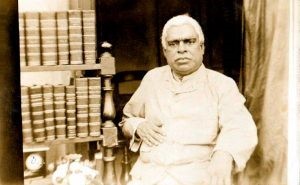
Even though it had only been a couple hundred years since Caitanya Mahaprabhu disappeared, His teachings were practically lost. It took Thakura eight constant years of trying to finally get his hands on a copy of the Sri Caitanya Caritamrta. Once he got his own copy of the Sri Caitanya Caritamrta and the Srimad Bhagavatam, Bhaktivinoda Thakura felt that his search for answers was done. He would constantly read the biography of Lord Caitanya over and over again. In his autobiography, Thakura stated that, *“From this time my respect and reverence for Sri Caitanyadeva was born. That seed of faith for the Vaishnava-dharma which was implanted within my heart soon sprouted. Now I love to study the Sastras dealing with Krishna both day and night.”*
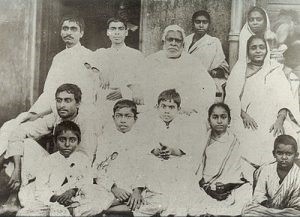
Between the years 1874 and 1893, Thakura Bhaktivinoda followed a rigid schedule, allowing him to manage all his duties and responsibilities along with his studies and writing.
8 pm – 10 pm Rest
10 pm – 4 am Write
4 am – 4:30 am Rest
4:30 am – 7 am Chant Japa
7 am – 7:30 am Correspondence
7:30 am – 9:30 am Study sastras
9:30 am – 10 am Bathe, simple prasadam
10 am – 1 pm Court duties
1 pm – 2 pm Refresh at home
2 pm – 5 pm Court duties
5 pm – 7 pm Translate Sanskrit sastras to Bengali
7 pm – 8 pm Bathe, simple prasadam
Thakura Bhaktivinoda rested for three hours in total, in order to fit in his studies and japa, which took roughly four and a half hours, his writing which took up about eight and a half hours, and his services for the government which took around six hours of his time. He followed it very strictly.
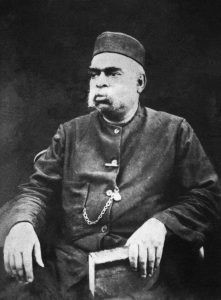
In the years to come, Srila Thakura Bhaktivinoda composed over one-hundred books and songs such as Sri Krishna-samhita, Jaiva Dharma, Sri Caitanya-sikshamrita, Vaishnava-siddhanta-mala, Prema-pradipa, Manah-shiksha, Saranagati, Gitamala, Gitavali and so on, as well as established many centers. He also defeated and dealt with many trouble makers such as:
– Mystic Bishakishena, who claimed he was God,
– Carana dasa Babaji who was printing bogus books and preaching philosophy that was not according to Sri Caitanya Mahaprabhu’s teachings,
– King of Puri at that time, who was using Jagannatha’s money for his own enjoyment,
By 1887, wanting to leave his government services, Bhaktivinoda Thakura desired to quickly leave to Vrndavan, and do bhajana, or meditation on the banks of the Yamuna river until the end of his life. One night following the Thakura’s thoughts, Sri Caitanya Mahaprabhu Himself appeared to Bhaktivinoda Thakura in a dream and told him:
“You will certainly go to Vrndavan, but first there is some service you must perform in Navadvipa, so what will you do about that?”The Lord then disappeared and Thakura Bhaktivinoda awoke, and thereafter was advised to apply for a government transfer to Krishnanagar, which is nearby to Navadvipa. The Thakura tried very hard to get a transfer to the holy dham of Lord Caitanya. Finally, after much endeavor and requests to be relieved of his official duties, Bhaktivinoda Thakura was finally able to arrange a mutual exchange with the Deputy Magistrate of Krishnanagar, Babu Radha Madhava Vasu, in the December of 1887 and thus, he finally went to Krishnanagar to execute the mission the Lord had given him.
While stationed in Krishnanagar, Bhaktivinoda Thakura would regularly visit the present day Navadvipa, searching for the Janmastan, or birthplace of Sri Caitanya Mahaprabhu. One Saturday evening, Thakura was sitting on the roof of the Rani Dharmasala in Navadvipa with his third son, Kamal Prasad, and a friend who was a clerk. It was late at night, around 10pm, it was very dark, and the sky was covered with clouds. Thakura then writes about is experience: “Across the Ganga, in the northern direction, I saw a large mansion flooded with light. When I asked Kamal [about this], he confirmed that he had seen it also. When I asked the clerk, he said, ‘I didn’t see anything.’ I was utterly amazed by that. When I looked carefully at that area in the morning from the roof of Rani’s house, I saw a tal [palm] tree located there.”
He inquired about the place, and learned that right next to that place was the ruins of an old fort and kingdom – large pond of King Ballal Sen, from which the town got its name of Ballaldighi. Aside from that, however, there was nothing of importance in that area. The following Saturday, Thakura went to Ballaldighi, where again at night, he had a wonderful vision. The next day, he wandered around the site, and the elderly locals told him that this was indeed the Janmastan of Sri Krishna Caitanya Mahaprabhu. They pointed out the Tulasi plants growing in abundance, none of them ever being planted.
Thakura Bhaktivinoda then began extensive research using old maps and manuscripts such as Caitanya Bhagavata, Bhakti Ratnakara, Narahari Sarakar Thakura’s Navadvipa-parikrama-paddhati, along with very old maps of the district. It was interesting to find that on one map in particular, from the late eighteenth century, the name “Sri Mayapura” was found on the map, which was later to be known as Ballaldighi. While reading Bhakti Ratnakara, he found the following verse, which confirmed his discovery:
navadvipa madhye mayapura name sthan
yathaya janmilen gauracandra bhagavan
Thakura Bhaktivinoda, to confirm it for sure, asked Srila Jagannatha Das Babaji, who was the head of the Gaudiya Vaisnava community to come to the site. Babaji Maharaja, being over one-hundred and twenty years old at that time was so weak, he had to be carried everywhere in a basket, and upon arriving at the place Bhaktivinoda Thakura discovered to be the birth place of Lord Caitanya, Babaji Maharaja literally jumped up into the air in ecstasy and cried “ei to ‘nimai-janma-bhumi!”, meaning ‘This is indeed the birth place of Lord Nimai!’ This was the ultimate confirmation, and proved beyond a shadow of a doubt that this was indeed the original birth place of Sri Krishna Caitanya Mahaprabhu. Therefore, from both a factual and spiritual point of view, the place of Lord Caitanya’s birth was thus confirmed. This monumental discovery took place toward the beginning of 1888, and was a landmark event in Gaudiya History. Thereafter, he began extensive research and re-discovered other pastime places of the Lord, and produced the book Sri Navadvipa Dhama Mahatmya which was published in 1890.
“In the center of Navadvipa there is a place called Mayapura. At this place the Supreme Lord, Gauracandra, took His birth.”
In August of 1891, Thakura was granted a two year break from his government services. He got a place in Godrumadvipa, commonly known as Svarupaganga, and it was there in Surabhi Kunja that he started the Nama-hatta, or the market place of the Holy Name. Thakura Bhaktivinoda established over five-hundred Nama-hatta sangas. He wrote an essay entitled Sri Godruma Kalpatavi. Within this newsletter collection, he describes the structure of the Nama-hatta. He humbly addressed himself as the sweeper of the market place. This composition was made to guide those leaders and members in the preaching movement, who are trying to lead a balanced Krishna conscious life, while maintaining a family and career.
The glories of this great personality are limitless, and his achievements are countless. Mere words cannot do justice to his glories. Although Bhaktivinoda Thakura is especially recognised for re-discovering the birth place of Lord Caitanya, he in fact re-discovered and re-established Lord Caitanya’s movement, which was practically lost due to the cultural and religious fanaticism of the British rulers, and the concocted philosophies of deviant sects, who aimed to discredit and contradict the original teachings of the Supreme Lord.
“Oh, for that day when the fortunate English, French, Russian, German and American people will take up banners, mrdangas and karatalas and raise kirtana through their streets and towns. When will that day come? Oh, for the day when the fair-skinned men from their side will raise up the chanting of ‘jaya sacinandana, jaya sacinandana ki jaya’ and join with the Bengali devotees. When will that day be? On such a day they will say, ‘Our dear Brothers, we have taken shelter of the ocean of Lord Caitanya’s Love; kindly embrace us.’ When will that day come? That day will witness the holy transcendental ecstasy of the Vaisnava-dharma to be the only dharma, and all the sects and religions will flow like rivers into the ocean of Vaisnava -dharma. When will that day come?”
-Bhaktivinoda Thakura
Bhaktivinode Asan Vigraha Pratishthapana
Day 1
Day 2
CONTACT US
Email Us: bhaktivinodeasan@gmail.com
Contact Person for Donations: H.G. Shyam Rasikananda Pr
Mobile / WhatsApp: 9875696276 / 8478950427
For any contribution using mobile payment app please use the following
UPI ID: q728773429@ybl
